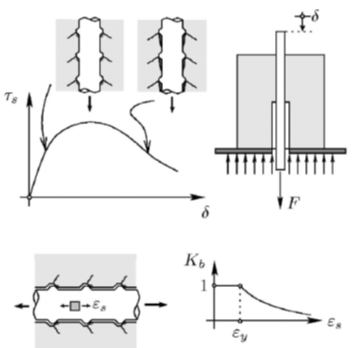|
Bond between steel and concrete is a fundamental topic for understanding
and modeling the behaviour of reinforced and prestressed concrete
structures. Physical models allowing to understand and model this
phenomenon in various regimes have been proposed by several authors.
At the Structural Concrete Laboratory, the phenomenon of bond has been
investigated from several perspectives, for instance:
Study of bond in the elastic and elasto-plastic regimes, with an
integration of the general analytical bond-slip laws with the hypothesis
of an affinity between the stress-strain profiles.
Study of crack opening after loading-unloading cycles.
Study of the phenomenon of spalling of the concrete cover due to
bond of ribbed bars, with application to curved elements.
|

Reference publications
Analytical bond model
- Fernández Ruiz M., Muttoni A., Gambarova P., Analytical modelling of the pre- and post-yield behaviour of bond in reinforced concrete, ASCE Journal of Structural Engineering, Vol. 133, N° 10, Reston, USA, 2007, pp. 1364-1372.
Influence of anchorage type and concrete cracking
- Brantschen F., Faria D. M. V., Fernández Ruiz M., Muttoni A., Bond Behaviour of Straight, Hooked, U-Shaped and Headed Bars in Cracked Concrete, Structural Concrete, 17 No. 5, 2016, pp. 799-810.
Influence of bond on cover spalling
Influence loading-unloading cycles on crack opening
|
